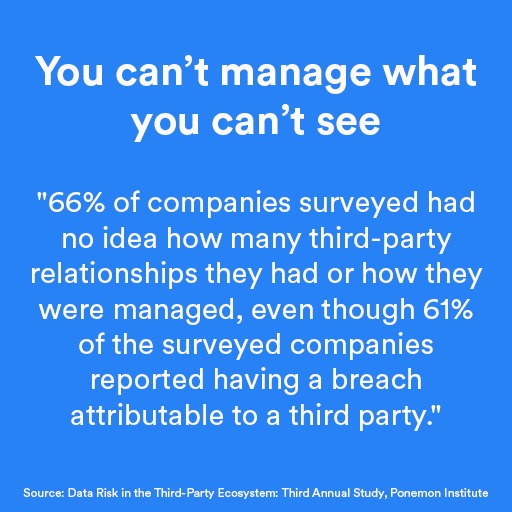
The pandemic, a constantly changing economy, and shifts in hiring practices mean that IT needs to be flexible in how they manage third parties in their organization without neglecting the policies and management that keep the company secure.
Third parties continue to be a challenge because:
Many organizations utilize contractors, vendors, and consultants to augment staffing, manage special projects, or maintain business operations. But securing access for these types of roles can be a challenge, especially across multiple locations, divisions, or subsidiaries. And for specific industries, such as healthcare, manufacturing, and technology, the compliance burden that accompanies managing this third-party access presents mounting challenges.
So, what happens when you have third parties that need specific access to data, applications, and services within your organization? How do you best manage this from a people, process, and technology perspective?
People
Your organization needs to utilize third parties for a variety of reasons and those reasons usually translate into a specific set of access needs. For example, if you have shift nurses at a hospital, they need access to their assigned floors as well as to the patient records for those under their care.
Processes
Onboarding and offboarding processes are usually quite well defined for full-time and part-time employees. Policies and processes must be defined for third-party access too. Many IT organizations struggle with simple visibility into who, what, and when third parties will be used, so managing them is a challenge.
Technology
Many organizations are challenged with shadow IT providing access to data, applications, physical locations, and services for third parties. Rather than using existing access management and governance solutions, managers can and do provide access directly to third parties. This not only means that policy can’t be followed but tracking and cutting that access can be nearly impossible without visibility into what access exists.
All of these challenges can translate into lost productivity, a widening attack surface, and an untraceable dent in your organization’s security.

Source: Data Risk in the Third-Party Ecosystem: Third Annual Study, Ponemon Institute https://www.ponemon.org/research/ponemon-library/security/data-risk-in-the-third-party-ecosystem-third-annual-study.html

Source: IBM Data Breach Report https://www.ibm.com/reports/data-breach
The importance of identity governance for third parties
Identity governance is a critical part of any organization’s security posture that ensures access is managed, logged, and verified on regular intervals. Many organizations struggle with managing third parties because they don’t have the same authoritative source for the identity data as standard employees do. And they also fall outside the standard identity lifecycle processes that IT uses to manage access due to the nature of the work they do. Projects can have shifting start dates and end dates, routine maintenance occurs on a schedule that doesn’t require constant access but can’t be done without it, and staff augmentation can occur at varying level with some people coming back to an organization multiple times.
Identity governance solutions provide critical visibility into who has what access, who approved that access, and whether it’s been used in a normal or anomalous fashion. This data allows security and risk teams to monitor usage and flag anything out of the ordinary to help maintain organizational security and manage their broad attack surface.
Identity governance solutions can also ensure that access meets internal policy and external regulatory requirements for compliance and reporting.
Clear Skye secures third-party access, the same way we do with employee access
For Clear Skye, access is access regardless of whether that access is for an employee, contractor, vendor, partner, or robot.
Here’s how Clear Skye solves third-party access challenges:
Excerpted from our new paper about how Clear Skye solves third-party access challenges.